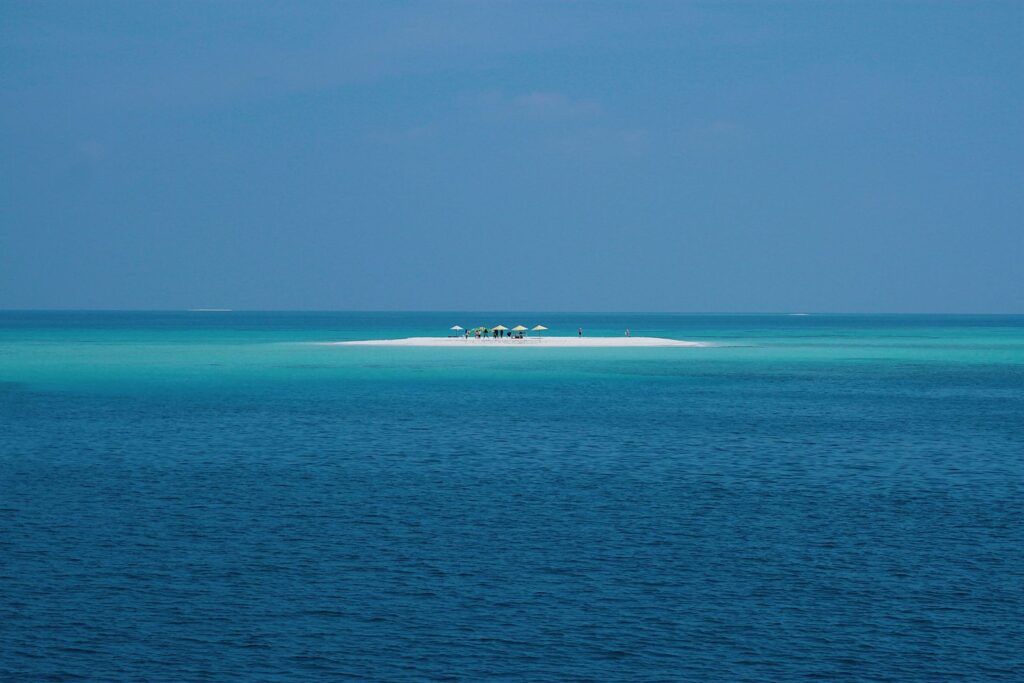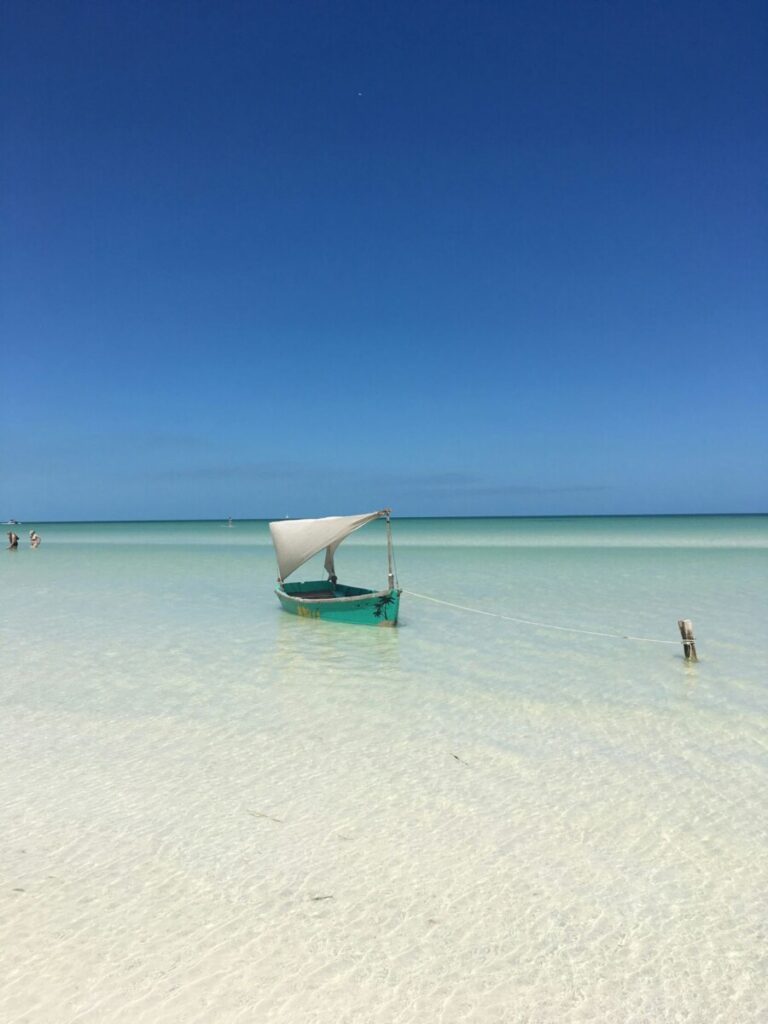One of the most visited destinations alongside Cooperating Volunteers is Zanzibar, an archipelago off the coast of Tanzania, famous for its paradise beaches, white sands, and turquoise waters.
Experiencing volunteering in this destination allows us to be part of community development while enjoying its dreamlike landscapes and all the activities it has to offer.
That’s why today, we want to talk about some of the most beautiful beaches in Zanzibar, so that when you travel, you can enjoy them during your free time.
Living the volunteering experience and enjoying the culture makes this trip unforgettable.

FEATURED BEACHES
- Nungwi Beach
Nungwi Beach is located at the northern tip of Unguja Island, the main island of the Zanzibar archipelago. It is about 55 km from Stone Town, the historic capital of the island, and the drive takes approximately 1.5 to 2 hours by road.
It is easily accessible by private taxi, hotel transfer, or organized excursions. Some people also choose to rent motorcycles or cars.
It is a beach with white, fine, and soft sand, considered among the best in Africa, with turquoise and crystal-clear water, ideal for swimming at any time of day. Unlike many other beaches in Zanzibar, Nungwi is not as affected by the tides, allowing for swimming all day long. The beach is lined with palm trees and tropical vegetation, with a horizon offering spectacular sunsets.
The main activities include: diving and snorkeling (there are many certified dive centers offering trips to nearby atolls, especially Mnemba Atoll), sailing on dhows (traditional wooden sailboats, often sailing at sunset to watch the sunset), kitesurfing and water sports (although not the most famous beach for it), deep-sea fishing excursions, marine life watching (turtles and dolphins), and party and nightlife (it is one of the beaches with the liveliest party scene).
There is a wide variety of accommodations and restaurants in the area, ranging from luxurious spots to more affordable ones, suitable for all budgets. It is a great place to try Swahili cuisine, and some popular places are: Langi Langi, Baraka Beach Restaurant, and Coco Cabana.
Additionally, in the nearby village, there are markets and local culture, including dhow-building workshops and sea turtle conservation centers to visit.
This beach is ideal for those looking for a lively beach, activities, good infrastructure, and the ability to swim without worrying about the tides. A perfect combination of natural beauty, local culture, and entertainment.
- Kendwa Beach
The Tranquil Gem of Zanzibar
Kendwa Beach is located on the northwest coast of Unguja Island, just 3 kilometers south of Nungwi. It is approximately 1.5–2 hours by road from Stone Town. You can easily reach it by taxi, private car, or hotel-organized transport services. Many people staying in Nungwi take coastal walks to Kendwa (about 30 minutes along the beach).
The sand is extraordinarily white, soft, and almost free of coral debris, making it perfect for walking barefoot. Its waters are turquoise, clear, and warm throughout the year. The tides vary very little, making Kendwa one of the few beaches in Zanzibar where you can swim comfortably at any time of day. The beach is wide, open, and less urbanized than other areas, giving it a more serene and natural atmosphere.
The main activities include: unrestricted swimming, ideal for swimmers of all levels, snorkeling and diving (there are operators offering trips from Kendwa), full moon parties (one of the most famous in the country, held once a month at Kendwa Rocks hotel with DJs, African drums, Maasai dances, and a multicultural vibe), paddleboarding, kayaking, and beach games easily accessible at the resorts, and pure relaxation.
There are various accommodation options, from backpacker hostels to resorts. Many are located right on the beach. The area is known for fresh seafood, Swahili, Indian, and Italian cuisine. Recommended: La Fontana, Essence Restaurant, and the seafood buffets at Sunset Kendwa. The atmosphere is calmer and more elegant than Nungwi but still offers options for those who want to socialize or enjoy music at night.
The best time to go is from June to October (dry weather, cooler temperatures) and January/February (dry heat). It is recommended to avoid April and May due to the intense rainy season.
Some of the most stunning sunsets on the island can be seen from this beach.
This beach is ideal for those seeking a balance between absolute rest and occasional nightlife. Being less crowded than Nungwi but still with good infrastructure, it is excellent for couples, honeymoons, and solo travelers who prefer a more peaceful yet not completely isolated environment.
- Paje Beach
Paje Beach is located on the southeast coast of Unguja Island, Zanzibar. It is about 50 km (1 to 1.5 hours by car) from Stone Town. Access is quite easy via taxis, private transfers, or public transportation (dala-dala) heading to the Michamvi or Jambiani region.
The sand on this beach is very white, powder-fine, perfect for walking or doing yoga on the beach. The water is light blue and very clear, with shades ranging from turquoise to emerald. The tides are pronounced, creating a changing landscape throughout the day. At low tide, an extensive flat seabed appears, allowing you to walk dozens of meters out to sea. It is surrounded by coconut trees, seagrass fields, and small mangroves further south.
The most popular activity is undoubtedly kitesurfing (main attraction); Paje is the kitesurfing epicenter of Zanzibar and one of the best places in the world for this sport. There are dozens of IKO-certified schools. The wind season is from June to August and December to February. But you can also do other activities like snorkeling and diving (there are dhow excursions to the lagoon or Blue Lagoon to explore nearby reefs), cultural tours like guided walks through the village of Paje, where you can see how locals live, their markets, and fishing or seaweed farming activities, yoga and wellness (many resorts offer seaside yoga classes, meditation, spa treatments, and massages), and also nightlife, though not as festive as Nungwi.
The accommodation style is bohemian, surfer, and eco-friendly, geared toward young travelers, digital nomads, and wellness enthusiasts. Though, as everywhere, there are different lodgings depending on each visitor’s budget.
It’s also a good place to try local dishes, international fusion, and healthy options. Organic cafés, vegetarian menus, and food made with local products abound.
Paje is one of the few beach towns with good infrastructure for digital nomads, such as workspaces with stable WiFi.
This beach is an ideal retreat for alternative travelers, kitesurf enthusiasts, yoga lovers, backpackers, and digital nomads. It has a diverse and relaxed international community that perfectly blends with the authentic charm of the local Swahili village. The beach is visually stunning, especially during tide transitions. A great place to connect with nature and yourself, without giving up modern services.

Jambiani Beach
Jambiani is located on the southeast coast of Unguja Island (Zanzibar), just south of Paje. It is about 56 km from Stone Town and is easily reached in approximately 1.5 hours by car. It shares the same access road as Paje, making it a common stop on routes to the southern part of the island.
It is accessible by taxi, hotel transfers, or dala-dala (local minibuses).
The sand is white and fine, very soft to the touch, perfect for long walks. The water is light blue with emerald green and turquoise reflections and has very little surf. The tides are very pronounced; during low tide, the sea retreats hundreds of meters, revealing a shallow seabed ideal for walking or collecting shellfish. The setting consists of a genuinely Swahili village, with palm trees, low vegetation, and traditional fishing life. Unlike Paje, tourism here has been more controlled, and development blends harmoniously with the local culture.
The main activities are cultural and related to local life, such as: visiting one of the most traditional and authentic villages in Zanzibar, seeing fishermen leave in their dhows in the morning and return at sunset, local women collecting seaweed (an economic pillar of the community), and organized walks to learn about schools, markets, and local homes.
Snorkeling and diving are also popular as there is very good visibility and nearby coral. There are dive centers, and excursions are organized to the Blue Lagoon or even to the outer coral reef.
Water sports are also practiced but are less developed than in Paje, although more kitesurfing schools are opening. Being in the southeast, it is more exposed to the wind between June and August, ideal for laid-back kitesurfers.
And as in other beaches, you can practice yoga, meditation, or simply relax.
The style of accommodations is calm, rustic, and cozy. Many lodgings are eco-friendly or community-focused. There are different options, from boutique hotels to hostels and guesthouses run by local families. Some recommended restaurants are: Lustania Restaurant, Bahari Pizza, Casa del Mar, and The Loop. You can try very fresh seafood, Swahili dishes, and lots of homemade cooking.
The nightlife atmosphere is very relaxed, with no nightclubs or big parties, but occasional live music, bonfires on the beach, and good conversation.
This beach is special because it has one of the island’s most genuine villages. The local people live there as they have for generations, with a warm welcome for travelers. If you’re looking for peace, disconnection, and real cultural contact, Jambiani is an ideal place. Many accommodations and tours are managed under ethical and ecological principles.
Matemwe Beach
Matemwe Beach is located on the northeast coast of Zanzibar, facing the famous Mnemba Atoll. It is about 50 km from Stone Town (approximately 1.5 hours by car). The road is scenic, passing through small towns like Kiwengwa and Mchangani. It is accessible by private taxi, organized transfer, or rental vehicle. There is no direct public transport that comfortably reaches the beach, which helps maintain its tranquility.
The sand is very white, fine, and almost free of debris. It is often described as “white flour underfoot.” The waters are turquoise, clear, and especially bright in the mornings. Perfect for landscape photography and swimming at high tide. The tides are also quite marked, and during low tide the sea recedes, revealing vast coral flats and seagrass beds. The beach is long, almost uninterrupted, and sparsely developed, surrounded by palm trees, small coastal forests, and coconut plantations.
The main activities include snorkeling and diving at Mnemba Atoll, one of the best diving spots in East Africa. There is a high chance of seeing dolphins, sea turtles, angelfish, napoleon fish, and vibrant reefs. As on other beaches, you can also sail on dhows, take coastal walks, do yoga and meditation, kayak and paddleboard, and take cultural excursions to Matemwe village (learn about traditional medicine, Swahili cooking, local crafts, or visit schools).
Accommodations are boutique-style, eco-friendly, and luxurious in a subdued sense, perfect for those seeking rest, natural aesthetics, and personalized service. You can also enjoy high-quality Swahili cuisine with a focus on fresh seafood, tropical fruits, and European fusion. Many hotels have restaurants open to the public.
A special beach to enjoy its waters, nature, and get away from the hustle and bustle.
Kiwengwa Beach
The “Little Caribbean” of Zanzibar with an Italian Flair
Kiwengwa is located on the northeast coast of Unguja Island, about 45 km (approximately 1 hour by car) from Stone Town. It is well connected by road and is located between Pongwe to the south and Matemwe to the north. It is one of the most accessible and developed beaches on the island.
The beach sand is incredibly white and fine, almost like talcum powder. Very extensive and perfect for walking, running, or practicing yoga by the sea. The water is bright turquoise, shallow, ideal for swimming at high tide. The tides are also marked; during low tide, the sea retreats considerably, exposing coral flats and creating natural pools ideal for exploring on foot. The surroundings consist of large beach stretches flanked by resorts, palm trees, coastal vegetation, and some forest inland. It offers a balance between nature and comfort.
You can do activities like swimming and walks, ideal for families, also kitesurfing and other water sports like paddleboarding, and of course snorkeling and diving. In addition to dhow excursions, massages, and cultural and ecological tours visiting nearby villages like Kinyasini (local market) and walks through coral caves or mangroves.
Accommodations are affordable luxury with a strong focus on European tourists, especially Italians. It is sometimes informally known as “Little Italy” of Zanzibar. That’s why the local cuisine is quite international and high quality, but with a strong presence of Italian food (homemade pasta, seafood Mediterranean style, authentic espresso).
It has a moderate nightlife scene with Maasai cultural shows, live Swahili music, theme nights at resorts, and some informal beach bars. It is quieter than Nungwi but livelier than Matemwe or Jambiani during high season. Perfect for those who want some action without noisy crowds.
Its stunning beaches and balance make it a fantastic spot.

These are just some of the many beaches you can find in Zanzibar, all of them with unforgettable landscapes and experiences that will make your trip indescribable.




